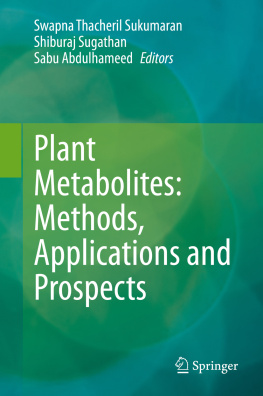
Table of Contents
List of Tables
- Chapter 01
- Chapter 04
- Chapter 05
- Chapter 06
- Chapter 07
- Chapter 08
List of Illustrations
- Chapter 01
- Chapter 02
- Chapter 04
- Chapter 05
- Chapter 06
- Chapter 07
- Chapter 08
Guide
Pages
Ethnobotany
A Phytochemical Perspective
Edited by B. M. Schmidt and D. M. Klaser Cheng
This edition first published 2017
2017 John Wiley & Sons Ltd
All rights reserved. No part of this publication may be reproduced, stored in a retrieval system, or transmitted, in any form or by any means, electronic, mechanical, photocopying, recording or otherwise, except as permitted by law. Advice on how to obtain permission to reuse material from this title is available at http://www.wiley.com/go/permissions.
The right of B. M. Schmidt and D. M. Klaser Cheng to be identified as the editors of this work/of the editorial material in this work has been asserted in accordance with law.
Registered Offices
John Wiley & Sons, Inc., 111 River Street, Hoboken, NJ 07030, USA
John Wiley & Sons Ltd, The Atrium, Southern Gate, Chichester, West Sussex, PO19 8SQ, UK
Editorial Office
111 River Street, Hoboken, NJ 07030, USA
For details of our global editorial offices, customer services, and more information about Wiley products visit us at www.wiley.com.
Wiley also publishes its books in a variety of electronic formats and by printondemand. Some content that appears in standard print versions of this book may not be available in other formats.
Limit of Liability/Disclaimer of Warranty
While the publisher and authors have used their best efforts in preparing this book, they make no representations or warranties with respect to the accuracy or completeness of the contents of this book and specifically disclaim any implied warranties of merchantability or fitness for a particular purpose. No warranty may be created or extended by sales representatives or written sales materials. The advice and strategies contained herein may not be suitable for your situation. You should consult with a professional where appropriate. Neither the publisher nor authors shall be liable for any loss of profit or any other commercial damages, including but not limited to special, incidental, consequential, or other damages.
Library of Congress CataloginginPublication data applied for
ISBN 9781118961902
Cover Image: Courtesy of Professor Ilya Raskin
Cover Design: Wiley
List of Contributors
C. Calfo
Facultad de Qumica y Biologa
Universidad de Santiago de Chile
Santiago, Chile
D. M. Klaser Cheng
Visiting Scientist
Rutgers University
New Brunswick, New Jersey, USA
M. D. Choudhury
Department of Life Science and
Bioinformatics
Assam University
Silchar, Assam, India
P. Chu
Department of Plant Biology and
Pathology, SEBS
Rutgers University
New Brunswick, New Jersey, USA
K. CubillosRoble
Facultad de Qumica y Biologa
Universidad de Santiago de Chile
Santiago, Chile
H. AguayoCumplido
Facultad de Recursos Naturales
Renovables
Universidad Arturo Prat
Iquique, Chile
J. DelatorreHerrera
Facultad de Recursos Naturales
Renovables
Universidad Arturo Prat
Iquique, Chile
M. H. Grace
Plants for Human Health Institute
North Carolina State University
Kannapolis, North Carolina, USA
B. L. Graf
Department of Plant Biology and
Pathology, SEBS
Rutgers University
New Brunswick, New Jersey, USA
W. Gu
Key Laboratory of Economic Plants and
Biotechnology
Kunming Institute of Botany
Chinese Academy of Sciences
Kunming, China.
M. Isman
Faculty of Land and Food Systems
University of British Columbia
Vancouver, British Columbia, Canada
C. JofrJimenez
Facultad de Qumica y Biologa
Universidad de Santiago de Chile
Santiago, Chile
J. Kellogg
Plants for Human Health Institute
North Carolina State University
Kannapolis, North Carolina, USA
S. Khatoon
Pharmacognosy and Ethnopharmacology
Division
CSIRNational Botanical Research Institute
Lucknow, Uttar Pradesh, India
P. Li
Key Laboratory of Economic Plants and
Biotechnology
Kunming Institute of Botany
Chinese Academy of Sciences
Kunming, Yunnan, China
M. A. Lila
Plants for Human Health Institute
North Carolina State University
Kannapolis, North Carolina, USA
C. Long
Kunming Institute of Botany
Chinese Academy of Sciences
Kunming, Yunnun, China
B. M. Schmidt
L'Oreal USA
Clark, New Jersey, USA
D. S. Ningombam
Department of Life Sciences
Manipur University
Imphal, Manipur, India
S. S. Ningthoujam
Department of Botany
Ghanapriya Womens College
Imphal, Manipur, India
K. S. Potsangbam
Department of Life Sciences
Manipur University
Imphal, Manipur, India
I. Raskin
Department of Plant Biology and
Pathology, SEBS
Rutgers University
New Brunswick, New Jersey, USA
L. E. Rojo
Facultad de Qumica y Biologa
Universidad de Santiago de Chile
Santiago, Chile
H. Singh
Plant Diversity, Systematics and
Herbarium Division
CSIRNational Botanical Research Institute
Lucknow, Uttar Pradesh, India
P. J. Smith
Division of Pharmacology
University of Cape Town Medical School
Cape Town, South Africa
A. D. Talukdar
Department of Life Science and
Bioinformatics
Assam University
Silchar, Assam, India
A. TroncosoFonseca
Facultad de Qumica y Biologa
Universidad de Santiago de Chile
Santiago, Chile
T. B. Tumer
Faculty of Arts and Sciences
Department of Molecular Biology and Genetics
anakkale Onsekiz Mart University,
Terzioglu Campus,
anakkale, Turkey
Foreword
Science, especially with the rise of the omics technologies, has made amazing strides to decipher and elucidate the capacity of plants to synthesize and accumulate natural products that are uniquely capable of interfacing with human therapeutic targets to prevent or treat chronic human diseases. However, these revelations made in the modern scientific community would hardly come as a surprise to many indigenous communities, who have relied on wellknown, highly potent medicinal plants for centuries. Modern science has only recently allowed us to characterize the phytochemical structures that provide antiinflammatory or chemopreventive relief to humans, or to discern their mechanisms of action, but the traditional ecological knowledge of native communities has both channeled the search for phytoactive compounds and guided tests for safety and efficacy based on long history of human use. This book illustrates how traditional ethnobotany enriches the scientific discovery process, and in turn, how science validates and reinforces the wisdom of the elders.
Mary Ann Lila
Director, Plants for Human Health Institute
David H. Murdock Distinguished Professor
Food Bioprocessing & Nutrition Sciences
North Carolina State University
North Carolina, USA
Next page










